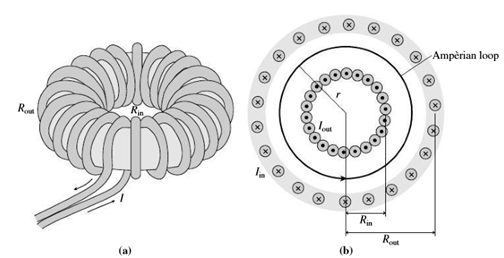
Concept explainers
A toroid is a solenoid-like coil bent into a circle (Fig. 26.52a). Toroids are the configuration of choice in magnetic-confinement nuclear fusion experiments, which, if successful, could provide us with an almost unlimited energy source using deuterium fuel extracted from seawater.
The ITER consortium, an international collaboration, is building a large toroidal fusion experiment in France; it’s expected to be the first fusion device to produce energy on a large scale. Figure 26.52b shows a cross section of a toroid, with current emerging from the page at the inner edge and descending at the outer edge. The black circle is an Ampèrian loop.

FIGURE 26.52 Diagram of (a) a toroidal coil and (b) a cross section of the coil (Passage Problems 88–91)
88. The magnetic field associated with the toroid is nonzero
- a. only within the “hole” in the donut-shaped coil.
- b. only within the region bounded by the coils.
- c. only outside the coils.
- d. everywhere.
89. In Fig. 26.52b, the magnetic field lines must be
- a. straight, and pointing into the page.
- b. straight, and pointing out of the page.
- c. straight, and pointing radially.
- d. circular.
90. Doubling the total number of turns N in the toroid, without changing its size or the current, will
- a. double the magnetic field.
- b. quadruple the magnetic field.
- c. halve the magnetic field.
- d. not change the magnetic field.
91. The toroid has inner radius Rin and outer radius Rout, while r is the radial coordinate measured from the center. The toroid is made from wire wound into a total of N turns, and carries current I. Which of the following is the correct formula for the magnetic field within the coils?
- a. B = μ0NI
- b. B = μ0NI/2πRin
- c. B = μ0NI/2πRout
- d. B = μ0NI/2πr
Want to see the full answer?
Check out a sample textbook solution
Chapter 26 Solutions
Essential University Physics (3rd Edition)
Additional Science Textbook Solutions
Anatomy & Physiology (6th Edition)
Biology: Life on Earth (11th Edition)
Campbell Essential Biology with Physiology (5th Edition)
Cosmic Perspective Fundamentals
Brock Biology of Microorganisms (15th Edition)
Chemistry: Structure and Properties (2nd Edition)
- I need help with part B. I cant seem to get the correct answer. Please walk me through what youre doing to get to the answer and what that could bearrow_forwardQuestion 6: Chlorine is widely used to purify municipal water supplies and to treat swimming pool waters. Suppose that the volume of a particular sample of Cl₂ gas is 8.70 L at 895 torr and 24°C. (a) How many grams of Cl₂ are in the sample? ⚫ Atomic mass of CI = 35.453 g/mol • Molar mass of Cl₂ = 2 x 35.453 = 70.906 g/mol Solution: Use the Ideal Gas Law: Step 1: Convert Given Values • Pressure: P = 895 torr → atm PV= = nRT 1 P = 895 × = 1.1789 atm 760 • Temperature: Convert to Kelvin: T24273.15 = 297.15 K • Gas constant: R = 0.0821 L atm/mol. K Volume: V = 8.70 L Step 2: Solve for n . PV n = RT n = (1.1789)(8.70) (0.0821)(297.15) 10.25 n = = 0.420 mol 24.405 Step 3: Calculate Mass of Cl₂ Final Answer: 29.78 g of Cl₂. mass nx M mass= (0.420)(70.906) mass= 29.78 garrow_forwardE1 R₁ w 0.50 20 Ω 12 R₁₂ ww ΒΩ R₂ 60 E3 C RA w 15 Ω E2 0.25 E4 0.75 Ω 0.5 Ωarrow_forward
- What is the force (in N) on the 2.0 μC charge placed at the center of the square shown below? (Express your answer in vector form.) 5.0 με 4.0 με 2.0 με + 1.0 m 1.0 m -40 με 2.0 μCarrow_forwardWhat is the force (in N) on the 5.4 µC charge shown below? (Express your answer in vector form.) −3.1 µC5.4 µC9.2 µC6.4 µCarrow_forwardAn ideal gas in a sealed container starts out at a pressure of 8900 N/m2 and a volume of 5.7 m3. If the gas expands to a volume of 6.3 m3 while the pressure is held constant (still at 8900 N/m2), how much work is done by the gas? Give your answer as the number of Joules.arrow_forward

 Modern PhysicsPhysicsISBN:9781111794378Author:Raymond A. Serway, Clement J. Moses, Curt A. MoyerPublisher:Cengage Learning
Modern PhysicsPhysicsISBN:9781111794378Author:Raymond A. Serway, Clement J. Moses, Curt A. MoyerPublisher:Cengage Learning Glencoe Physics: Principles and Problems, Student...PhysicsISBN:9780078807213Author:Paul W. ZitzewitzPublisher:Glencoe/McGraw-Hill
Glencoe Physics: Principles and Problems, Student...PhysicsISBN:9780078807213Author:Paul W. ZitzewitzPublisher:Glencoe/McGraw-Hill Physics for Scientists and Engineers: Foundations...PhysicsISBN:9781133939146Author:Katz, Debora M.Publisher:Cengage Learning
Physics for Scientists and Engineers: Foundations...PhysicsISBN:9781133939146Author:Katz, Debora M.Publisher:Cengage Learning College PhysicsPhysicsISBN:9781938168000Author:Paul Peter Urone, Roger HinrichsPublisher:OpenStax College
College PhysicsPhysicsISBN:9781938168000Author:Paul Peter Urone, Roger HinrichsPublisher:OpenStax College Principles of Physics: A Calculus-Based TextPhysicsISBN:9781133104261Author:Raymond A. Serway, John W. JewettPublisher:Cengage Learning
Principles of Physics: A Calculus-Based TextPhysicsISBN:9781133104261Author:Raymond A. Serway, John W. JewettPublisher:Cengage Learning





